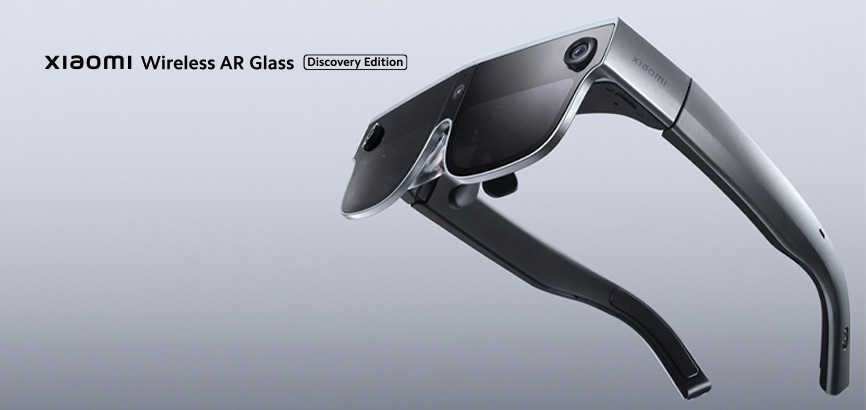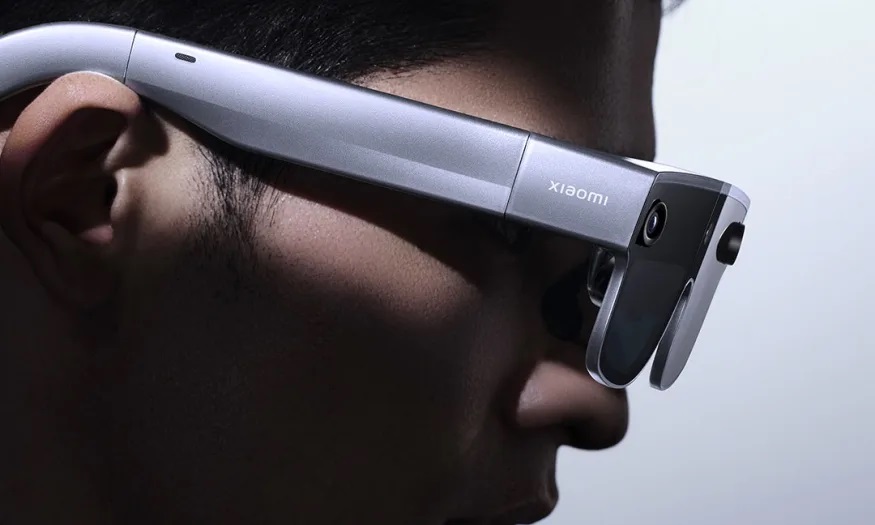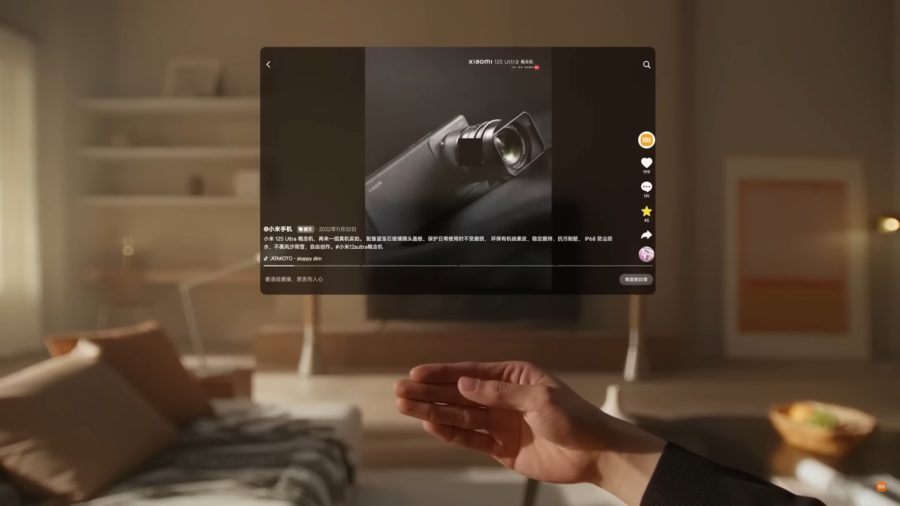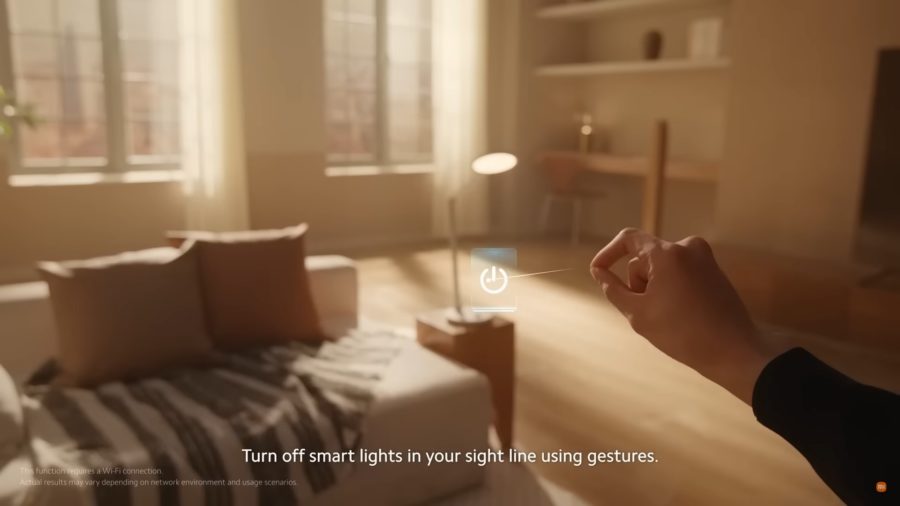 In Augmented Reality News
In Augmented Reality News
March 2, 2023 – Xiaomi, a provider of consumer electronics and smart manufacturing solutions, has this week announced at Mobile World Congress 2023 (MWC 2023) its brand new augmented reality (AR) glasses with the introduction of the Xiaomi Wireless AR Glass Discovery Edition.
The glasses represent Xiaomi’s first wireless AR device to utilize distributed computing, and offer a retina-level adaptive display that adjusts to the lighting environment. With enhanced connectivity to a Snapdragon Spaces ready smartphone, the company’s new AR device enables innovative hand tracking at a refined level, supports a comprehensive range of applications for larger displays, and offers innovations in inter-device compatibility, according to Xiaomi.
Connectivity on the Xiaomi Wireless AR Glass Discovery Edition
Instead of relying on a wired connection to a host computing device, Xiaomi’s AR glasses weigh just 126g and adopt Xiaomi-developed high-speed interconnection buses to achieve high-speed data connection from a smartphone. Built on the Snapdragon XR2 Gen 1 Platform and featuring Xiaomi’s proprietary low-latency communication link, the company states that its glasses, which support Qualcomm’s Snapdragon Spaces XR Developer Platform, offer a wireless latency of as low as 3ms between a smartphone device to the glasses, and a wireless connection comparable to wired solutions with full link latency as low as 50ms.

Lightweight AR glasses design
Xiaomi Wireless AR Glass Discovery Edition features a lightweight design aimed at minimizing any physical burden on the user by incorporating a magnesium-lithium alloy, carbon fiber parts, and a self-developed silicon-oxygen anode battery. According to Xiaomi, the glasses have been calibrated with precision, with the company taking into account details such as the center of gravity, leg spacing, angle, nose rest, and other factors all based on the analysis of tens of thousands of head tracking data samples.

Xiaomi Wireless AR Glass Discovery Edition display and optics
The glasses are also amongst the industry’s first to achieve a “retina-level” display, according to the company. Xiaomi noted that there exists a “critical value” quality threshold for AR glasses, and when angular resolution or PPD (pixels per degree) approaches 60, the human eye cannot distinguish granularity. The PPD of the Xiaomi Wireless AR Glasses is 58.
Leveraging a free-form optical module that comprises a pair of MicroOLED screens, Xiaomi Wireless AR Glass also comes with free-form light-guiding prisms to achieve a clear picture display. These free-form prisms are capable of performing complex light refraction in a limited volume. The content displayed on the screen is reflected by three surfaces within the light-guiding prisms, resulting in a final presentation in front of the user’s eyes.
The AR glasses’ optical module design minimizes light loss and produces clear and bright images with a to-eye brightness of up to 1200 nits, providing a strong foundation for AR applications. Additionally, the AR glasses come equipped with electrochromic lenses that can adapt to different lighting conditions. These lenses enable a blackout mode that offers an immersive experience when viewing content, while the transparent mode produces a more vivid AR experience that blends reality and virtual elements.

Xiaomi’s innovative take on AR gesture control
Xiaomi’s new glasses also feature micro gesture interactions that enable one-handed gesture interaction for users by utilizing the joints of the user’s inner fingers as a gesture recognition area. The company explained that the directional is oriented from the second joint of the middle finger, with the second joint of the index finger representing the upward direction. When combined with the surrounding areas, this forms a four-way directional key for basic movement operations. In addition, the 12 knuckles allow for text input through thumb tapping in the finger area. The thumb sliding on the index finger is used to enter and exit applications. Looking forward, Xiaomi stated that it hopes to enable sliding and tapping operations through the random movement of the thumb in the palm.
According to the company, these micro gestures on the Xiaomi Wireless AR Glass will enable users to perform daily app usage operations such as selecting and opening apps, swiping through pages, and exiting apps to return to the start page, all without using a smartphone for controls.
Xiaomi Wireless AR Glass incorporates a low power-usage AON camera that enables prolonged gesture interaction and facilitates features. However, users can also opt for conventional smartphone controls, which can be paired and used as a gesture or touchpad controller.

Control smart devices in AR with the Xiaomi Wireless AR Glass Discovery Edition
The glasses support a variety of large-screen applications, as well as popular apps like TikTok and YouTube. Additionally, the AR capability of the device allows users to place familiar apps anywhere in their viewing space and adjust their interface size via spatial gestures.
Additionally, as a provider of smart home solutions, Xiaomi has integrated AR to offer a unique experience to users. For instance, Xiaomi Wireless AR Glass allows users to “grab” the screen from a typical television screencast, and then continue watching it on the glasses. Xiaomi has also extracted common operations of smart devices, enabling users to operate devices through AR scenes. For example, when looking at a lamp, users can use spatial gestures to click a virtual button to turn that lamp on or off, according to Xiaomi. The company has also integrated a spatial audio experience, allowing virtual speakers to be linked with the real environment.

Xiaomi Wireless AR Glasses Discovery Edition requires pairing with Xiaomi 13 or other Snapdragon Spaces ready devices. The glasses are compatible with Qualcomm Snapdragon Spaces, OpenXR, and Microsoft MRTK development frameworks, and Xiaomi added that it intends to work closely with developers to expedite the widespread adoption of AR.
For more information on Xiaomi and its new AR glasses, please visit the company’s website.
Image / video credit: Xiaomi / YouTube
About the author
Sam is the Founder and Managing Editor of Auganix. With a background in research and report writing, he has been covering XR industry news for the past seven years.




